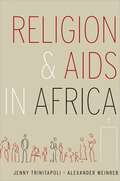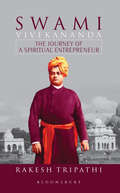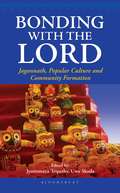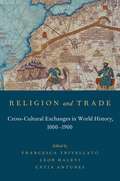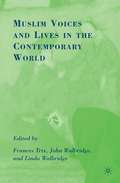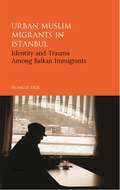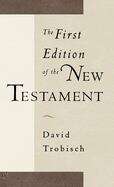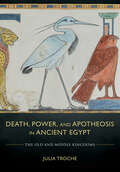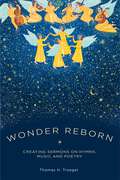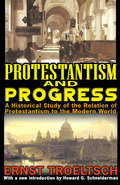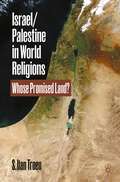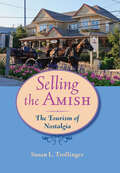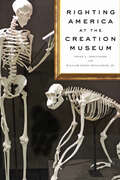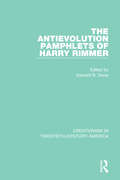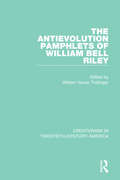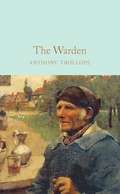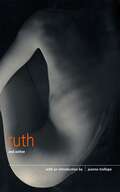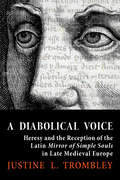- Table View
- List View
Religion and AIDS in Africa
by Jenny Trinitapoli Alexander WeinrebThe first comprehensive empirical account of how religion affects the interpretation, prevention, and mitigation of AIDS in Africa, the world's most religious continent.
Religion and AIDS in Africa
by Jenny Trinitapoli Alexander WeinrebThe first comprehensive empirical account of how religion affects the interpretation, prevention, and mitigation of AIDS in Africa, the world's most religious continent.
Swami Vivekananda: The Journey of a Spiritual Entrepreneur
by Rakesh TripathiSwami Vivekananda: The Journey of a Spiritual Entrepreneur details the events of Vivekananda's life, encompassing his transformation from a nameless wanderer to the most renowned representative of Hinduism of all times. In this book, we come across the Vivekananda who not only created history by delivering the Chicago Lecture in 1893 but also established the Ramakrishna Order through an unparalleled entrepreneurial spirit which brought to the fore his qualities as a decisive leader and an excellent communicator who reached out globally to convey the message of the Vedanta. These attributes of Vivekananda's personality have remained largely unexplored in most of the books written on him. This book also maps Hinduism and its present-day challenges vis-à-vis its attributes in light of Swami Vivekananda's philosophy and brings forth its contemporary relevance in a practical manner for the reader at a time when the fire of fundamentalism among different faiths has turned religions of the world essentially into separating factors within humanity. Further, it also contains detailed descriptions of practical approaches to translation that will help scholars build a comprehensive framework for translation of complex texts such as the Vedas and Upanishads. It finally concludes with the Indian media's articulate advocacy of Vivekananda's approach on a number of platforms in recent times, to unite humanity despite all its diversity as it is ever more relevant today.
Bonding with the Lord: Jagannath, Popular Culture and Community Formation
by Jyotirmaya Tripathy Uwe SkodaFew other Hindu gods guide a regional consciousness, pervade walks of everyday life and define a collective psyche the way Lord Jagannath does in Odisha and its contiguous areas. Jagannath is metonymic of Odisha and the Odia way of life, arguably much more than any other god for a particular geography or its peoples.While not derecognising the historical and the spiritual aspects of Jagannath, Bonding with the Lord attempts to look at the deployment of Jagannath in contemporary cultural practices involving the sensorium in the widest sense. The project of a cultural Jagannath not only materialises him in people's everyday practices but also democratises scholarship on him. The expansion of the scope of research on Jagannath to cultural expressions in a more encompassing way rather than confining to 'elitist' religious/literary sources makes him an everyday presence and significantly enhances his sphere of influence. Jagannath's 'tribal' origin, his association with Buddhism and Jainism and his avatari status make him an all-encompassing, multilayered symbol and a treasure trove for multiple interpretations.
Bonding with the Lord: Jagannath, Popular Culture and Community Formation
by Jyotirmaya Tripathy Uwe SkodaFew other Hindu gods guide a regional consciousness, pervade walks of everyday life and define a collective psyche the way Lord Jagannath does in Odisha and its contiguous areas. Jagannath is metonymic of Odisha and the Odia way of life, arguably much more than any other god for a particular geography or its peoples.While not derecognising the historical and the spiritual aspects of Jagannath, Bonding with the Lord attempts to look at the deployment of Jagannath in contemporary cultural practices involving the sensorium in the widest sense. The project of a cultural Jagannath not only materialises him in people's everyday practices but also democratises scholarship on him. The expansion of the scope of research on Jagannath to cultural expressions in a more encompassing way rather than confining to 'elitist' religious/literary sources makes him an everyday presence and significantly enhances his sphere of influence. Jagannath's 'tribal' origin, his association with Buddhism and Jainism and his avatari status make him an all-encompassing, multilayered symbol and a treasure trove for multiple interpretations.
Religion and Trade: Cross-Cultural Exchanges in World History, 1000-1900
by Francesca Trivellato Leor Halevi Catia AntunesAlthough trade connects distant people and regions, bringing cultures closer together through the exchange of material goods and ideas, it has not always led to unity and harmony. From the era of the Crusades to the dawn of colonialism, exploitation and violence characterized many trading ventures, which required vessels and convoys to overcome tremendous technological obstacles and merchants to grapple with strange customs and manners in a foreign environment. Yet despite all odds, experienced traders and licensed brokers, as well as ordinary people, travelers, pilgrims, missionaries, and interlopers across the globe, concocted ways of bartering, securing credit, and establishing relationships with people who did not speak their language, wore different garb, and worshipped other gods. Religion and Trade: Cross-Cultural Exchanges in World History, 1000-1900 focuses on trade across religious boundaries around the Mediterranean Sea and the Atlantic and Indian Oceans during the second millennium. Written by an international team of scholars, the essays in this volume examine a wide range of commercial exchanges, from first encounters between strangers from different continents to everyday transactions between merchants who lived in the same city yet belonged to diverse groups. In order to broach the intriguing yet surprisingly neglected subject of how the relationship between trade and religion developed historically, the authors consider a number of interrelated questions: When and where was religion invoked explicitly as part of commercial policies? How did religious norms affect the everyday conduct of trade? Why did economic imperatives, political goals, and legal institutions help sustain commercial exchanges across religious barriers in different times and places? When did trade between religious groups give way to more tolerant views of "the other" and when, by contrast, did it coexist with hostile images of those decried as "infidels"? Exploring captivating examples from across the world and spanning the course of the second millennium, this groundbreaking volume sheds light on the political, economic, and juridical underpinnings of cross-cultural trade as it emerged or developed at various times and places, and reflects on the cultural and religious significance of the passage of strange persons and exotic objects across the many frontiers that separated humankind in medieval and early modern times.
Muslim Voices and Lives in the Contemporary World
by F. Trix J. WalbridgeThis book tells the stories of eleven remarkable people in the Islamic world, from a religious musician in Pakistan who sings the sufferings of the saints and hopes to bring reconciliation to his country, to the son of one of the greatest Shi'ite scholars of Iraq who was murdered trying to restore peace in his city.
Urban Muslim Migrants in Istanbul: Identity and Trauma Among Balkan Immigrants (Library of Modern Turkey)
by Frances TrixSince the Russo-Turkish War of 1877-8, approximately two and a half million Muslims living in the Balkans have been forced from their homes. Some fled following World War II, and travelled east by train to Istanbul with no more than a suitcase. And yet 50 years later, one of their migrant associations was second only to the Red Crescent in providing aid to the urban poor of Istanbul. Frances Trix analyses the development of the oldest such association, originally founded to welcome new migrants as they arrived from Skopje after World War II, and shows how Islam is central to its structure and practices. Her wide-ranging study variously focuses on its leadership, the growing role of women in the organisation, and the importance of music and poetry in coping with exile. In so doing, she raises wider questions concerning the preservation and articulation of identity amongst migrant communities. Urban Muslim Migrants in Istanbul is a rare ethnography of an Islamic urban group based on extensive archival research and interviews in various languages across Istanbul, Skopje and Kosovo. Trix's unique approach brings a human element to the study of forced migration, conflict and trauma and it is an important book for academics and policymakers interested in the Balkans, the Middle East, Turkey and migration studies.
The First Edition Of The New Testament: (pdf)
by David TrobischThe First Edition of the New Testament is a groundbreaking book that argues that the New Testament is not the product of a centuries-long process of development. Its history, David Trobisch finds, is the history of a book--an all Greek Christian bible--published as early as the second century C.E. and intended by its editors to be read as a whole. Trobisch claims that this bible achieved wide circulation and formed the basis of all surviving manuscripts of the New Testament.
Death, Power, and Apotheosis in Ancient Egypt: The Old and Middle Kingdoms
by Julia TrocheDeath, Power, and Apotheosis in Ancient Egypt uniquely considers how power was constructed, maintained, and challenged in ancient Egypt through mortuary culture and apotheosis, or how certain dead in ancient Egypt became gods. Rather than focus on the imagined afterlife and its preparation, Julia Troche provides a novel treatment of mortuary culture exploring how the dead were mobilized to negotiate social, religious, and political capital in ancient Egypt before the New Kingdom. Troche explores the perceived agency of esteemed dead in ancient Egyptian social, political, and religious life during the Old and Middle Kingdoms (c. 2700–1650 BCE) by utilizing a wide range of evidence, from epigraphic and literary sources to visual and material artifacts. As a result, Death, Power, and Apotheosis in Ancient Egypt is an important contribution to current scholarship in its collection and presentation of data, the framework it establishes for identifying distinguished and deified dead, and its novel argumentation, which adds to the larger academic conversation about power negotiation and the perceived agency of the dead in ancient Egypt.
Wonder Reborn: Creating Sermons on Hymns, Music, and Poetry
by Thomas TroegerThis book explores an issue at the nerve of the long term health of all churches: how godly wonder can be reborn through renewed attention to the place of beauty in preaching and worship. The book opens with an exploration of the theological and cultural difficulties of defining beauty. It traces the church's historical ambivalence about beauty and art and describes how, in our own day, the concept of beauty has been commercialized and degraded. Troeger develops a theologically informed aesthetic that provides a counter-cultural vision of beauty flowing from the love of God. The book demonstrates how preachers can reclaim the place of beauty in preaching and worship. Chapter two employs the concept of midrash to mine the history of congregational song as a resource for sermons. Chapter three introduces methods from musicology for creating sermons on instrumental and choral works and for integrating word and music more effectively. Chapter four explores how the close relationship between poetry and prayer can stir the homiletical imagination. Each of these chapters includes a selection of the author's sermons illustrating how preachers can use these varied art forms to open a congregation to the beauty of God. A final chapter recounts the responses of congregation members to whom the sermons were delivered. It uses the insights gained from those experiences to affirm how the human heart hungers for a vision of wonder and beauty that empowers people to live more faithfully in the world.
Wonder Reborn: Creating Sermons on Hymns, Music, and Poetry
by Thomas TroegerThis book explores an issue at the nerve of the long term health of all churches: how godly wonder can be reborn through renewed attention to the place of beauty in preaching and worship. The book opens with an exploration of the theological and cultural difficulties of defining beauty. It traces the church's historical ambivalence about beauty and art and describes how, in our own day, the concept of beauty has been commercialized and degraded. Troeger develops a theologically informed aesthetic that provides a counter-cultural vision of beauty flowing from the love of God. The book demonstrates how preachers can reclaim the place of beauty in preaching and worship. Chapter two employs the concept of midrash to mine the history of congregational song as a resource for sermons. Chapter three introduces methods from musicology for creating sermons on instrumental and choral works and for integrating word and music more effectively. Chapter four explores how the close relationship between poetry and prayer can stir the homiletical imagination. Each of these chapters includes a selection of the author's sermons illustrating how preachers can use these varied art forms to open a congregation to the beauty of God. A final chapter recounts the responses of congregation members to whom the sermons were delivered. It uses the insights gained from those experiences to affirm how the human heart hungers for a vision of wonder and beauty that empowers people to live more faithfully in the world.
Protestantism and Progress: A Historical Study of the Relation of Protestantism to the Modern World
by Ernst TroeltschErnst Troeltsch focuses his Protestantism and Progress on two main areas. First, he centers on the intellectual and religious situation, from which the significance and the possibilities of development possessed by Christianity might be deduced. This leads to an engaging historical investigation regarding the spirit of the modern world. Troeltsch argues that the modern world can only be understood in the light of its relation to earlier epochs of Christian civilization in Europe. He notes that for anyone who holds the opinion that in spite of all the significance that Catholicism retains, the living possibilities of development and progress are to be found on Protestant soil, the question regarding the relation of Protestantism to modern civilization becomes of central importance.Troeltsch also distinguishes elements in modern civilization that have proven their value from those which are merely temporary and lead nowhere. He gives the religious ideas of Christianity a shape and form capable of doing justice to the absoluteness of religious conviction, and at the same time considering them in harmony with what has actually been accomplished towards solution of the practical problems of the Christian life.A new introduction by Howard Schneiderman brings this monumental work into the twenty-first century, and explains why its ideas are more important than ever, one hundred years after its original publication.
Protestantism and Progress: A Historical Study of the Relation of Protestantism to the Modern World
by Ernst TroeltschErnst Troeltsch focuses his Protestantism and Progress on two main areas. First, he centers on the intellectual and religious situation, from which the significance and the possibilities of development possessed by Christianity might be deduced. This leads to an engaging historical investigation regarding the spirit of the modern world. Troeltsch argues that the modern world can only be understood in the light of its relation to earlier epochs of Christian civilization in Europe. He notes that for anyone who holds the opinion that in spite of all the significance that Catholicism retains, the living possibilities of development and progress are to be found on Protestant soil, the question regarding the relation of Protestantism to modern civilization becomes of central importance.Troeltsch also distinguishes elements in modern civilization that have proven their value from those which are merely temporary and lead nowhere. He gives the religious ideas of Christianity a shape and form capable of doing justice to the absoluteness of religious conviction, and at the same time considering them in harmony with what has actually been accomplished towards solution of the practical problems of the Christian life.A new introduction by Howard Schneiderman brings this monumental work into the twenty-first century, and explains why its ideas are more important than ever, one hundred years after its original publication.
Israel/Palestine in World Religions: Whose Promised Land?
by S. Ilan TroenThe struggle over Israel/Palestine is not just another contest by competing nationalisms or an instance of geopolitical competition. It is also about control of sacred territory that involves local Jews, Muslims, and Christians as well as worldwide faith communities, each with their own interests and stake in what transpires. This balanced introduction to a complex subject presents the multiple positions within the great monotheistic traditions. It demonstrates that the secular discourses in the public square concerning ownership privileges, historical precedence, political rights, and justice that have allegedly replaced religious claims actually coexist with, and often complement, the theological. It explores the century-long tangle of secular and theological debates about Israel’s legitimacy. Whether readers support a Jewish state or are resolutely opposed, the serious and substantial scholarship of this well-reasoned and innovative book will contribute to a nuanced and better-informed understanding of this persistent issue that has entered its second century on the international agenda.
Selling the Amish: The Tourism of Nostalgia (Young Center Books in Anabaptist and Pietist Studies)
by Susan L. TrollingerMore than 19 million tourists flock to Amish Country each year, drawn by the opportunity to glimpse "a better time" and the quaint beauty of picturesque farmland and handcrafted quilts. What they may find, however, are elaborately themed town centers, outlet malls, or even a water park. Susan L. Trollinger explores this puzzling incongruity, showing that Amish tourism is anything but plain and simple.Selling the Amish takes readers on a virtual tour of three such tourist destinations in Ohio’s Amish Country, the world’s largest Amish settlement. Trollinger examines the visual rhetoric of these uniquely themed places—their architecture, interior decor, even their merchandise and souvenirs—and explains how these features create a setting and a story that brings tourists back year after year.This compelling story is, Trollinger argues, in part legitimized by the Amish themselves. To Americans faced with anxieties about modern life, being near the Amish way of life is comforting. The Amish seem to have escaped the rush of contemporary life, the confusion of gender relations, and the loss of ethnic heritage. While the Amish way supports the idealized experience of these tourist destinations, it also raises powerful questions. Tourists may want a life uncomplicated by technology, but would they be willing to drive around in horse-drawn buggies in order to achieve it?Trollinger's answers to important questions in her fascinating study of Amish Country tourism are sure to challenge readers’ understanding of this surprising cultural phenomenon.
Selling the Amish: The Tourism of Nostalgia (Young Center Books in Anabaptist and Pietist Studies)
by Susan L. TrollingerMore than 19 million tourists flock to Amish Country each year, drawn by the opportunity to glimpse "a better time" and the quaint beauty of picturesque farmland and handcrafted quilts. What they may find, however, are elaborately themed town centers, outlet malls, or even a water park. Susan L. Trollinger explores this puzzling incongruity, showing that Amish tourism is anything but plain and simple.Selling the Amish takes readers on a virtual tour of three such tourist destinations in Ohio’s Amish Country, the world’s largest Amish settlement. Trollinger examines the visual rhetoric of these uniquely themed places—their architecture, interior decor, even their merchandise and souvenirs—and explains how these features create a setting and a story that brings tourists back year after year.This compelling story is, Trollinger argues, in part legitimized by the Amish themselves. To Americans faced with anxieties about modern life, being near the Amish way of life is comforting. The Amish seem to have escaped the rush of contemporary life, the confusion of gender relations, and the loss of ethnic heritage. While the Amish way supports the idealized experience of these tourist destinations, it also raises powerful questions. Tourists may want a life uncomplicated by technology, but would they be willing to drive around in horse-drawn buggies in order to achieve it?Trollinger's answers to important questions in her fascinating study of Amish Country tourism are sure to challenge readers’ understanding of this surprising cultural phenomenon.
Righting America at the Creation Museum (Medicine, Science, and Religion in Historical Context)
by Susan L. Trollinger William Vance Trollinger Jr.On May 28, 2007, the Creation Museum opened in Petersburg, Kentucky. Aimed at scientifically demonstrating that the universe was created less than ten thousand years ago by a Judeo-Christian god, the museum is hugely popular, attracting millions of visitors over the past eight years. Surrounded by themed topiary gardens and a petting zoo with camel rides, the site conjures up images of a religious Disneyland. Inside, visitors are met by dinosaurs at every turn and by a replica of the Garden of Eden that features the Tree of Life, the serpent, and Adam and Eve.In Righting America at the Creation Museum, Susan L. Trollinger and William Vance Trollinger, Jr., take readers on a fascinating tour of the museum. The Trollingers vividly describe and analyze its vast array of exhibits, placards, dioramas, and videos, from the Culture in Crisis Room, where videos depict sinful characters watching pornography or considering abortion, to the Natural Selection Room, where placards argue that natural selection doesn;€™t lead to evolution. The book also traces the rise of creationism and the history of fundamentalism in America.This compelling book reveals that the Creation Museum is a remarkably complex phenomenon, at once a "natural history" museum at odds with contemporary science, an extended brief for the Bible as the literally true and errorless word of God, and a powerful and unflinching argument on behalf of the Christian right.
Righting America at the Creation Museum (Medicine, Science, and Religion in Historical Context)
by Susan L. Trollinger William Vance Trollinger Jr.On May 28, 2007, the Creation Museum opened in Petersburg, Kentucky. Aimed at scientifically demonstrating that the universe was created less than ten thousand years ago by a Judeo-Christian god, the museum is hugely popular, attracting millions of visitors over the past eight years. Surrounded by themed topiary gardens and a petting zoo with camel rides, the site conjures up images of a religious Disneyland. Inside, visitors are met by dinosaurs at every turn and by a replica of the Garden of Eden that features the Tree of Life, the serpent, and Adam and Eve.In Righting America at the Creation Museum, Susan L. Trollinger and William Vance Trollinger, Jr., take readers on a fascinating tour of the museum. The Trollingers vividly describe and analyze its vast array of exhibits, placards, dioramas, and videos, from the Culture in Crisis Room, where videos depict sinful characters watching pornography or considering abortion, to the Natural Selection Room, where placards argue that natural selection doesn;€™t lead to evolution. The book also traces the rise of creationism and the history of fundamentalism in America.This compelling book reveals that the Creation Museum is a remarkably complex phenomenon, at once a "natural history" museum at odds with contemporary science, an extended brief for the Bible as the literally true and errorless word of God, and a powerful and unflinching argument on behalf of the Christian right.
The Antievolution Pamphlets of Harry Rimmer
by William Vance TrollingerOriginally published in 1995, The Antievolution Pamphlets of Harry Rimmer is the sixth volume in the series, Creationism in Twentieth Century America. The volume brings together original sources from the prominent evangelist and pastor Harry Rimmer. The consortium of pamphlets in this volume detail Rimmer’s antievolutionist sentiments, a notion which characterized his early writings. The pamphlets detail Rimmer’s rhetoric on evolution and science from the early part of the 20th century as he travelled across America to disseminate his writings. The works in this volume address Rimmer’s polemic on the danger posed by modern science and the consequential disassociation with religion. While Rimmer did not discount science itself, he argued for, what he termed, ‘true science’, claiming that modern science was based only in scientific opinion and not fact. As a self-proclaimed scientist, these writings take a unique view of the relationship between religion and science from this period through Rimmer’s dual nature as both scientist and pastor. This volume will be of great interest to historians of natural history, science and religion.
The Antievolution Pamphlets of William Bell Riley
by William Vance TrollingerOriginally published in 1995, The Antievolution Pamphlets of William Bell Riley is the fourth volume in the series, Creationism in Twentieth Century America, reissued in 2021. The volume comprises of nine antievolution pamphlets written by William Bell Riley during the interwar years. The pamphlets detail Riley’s antievolutionist ideas and activities, and the book attempts to place the work in the larger contexts of Riley’s career, as well as discussing the pamphlets included. The collection will be of especial interest to natural historians, and theologians as well as academics of philosophy, and history.
The Antievolution Pamphlets of William Bell Riley
by William Vance TrollingerOriginally published in 1995, The Antievolution Pamphlets of William Bell Riley is the fourth volume in the series, Creationism in Twentieth Century America, reissued in 2021. The volume comprises of nine antievolution pamphlets written by William Bell Riley during the interwar years. The pamphlets detail Riley’s antievolutionist ideas and activities, and the book attempts to place the work in the larger contexts of Riley’s career, as well as discussing the pamphlets included. The collection will be of especial interest to natural historians, and theologians as well as academics of philosophy, and history.
The Warden: First Of The Barsetshire Novels (Macmillan Collector's Library)
by Anthony TrollopeThe Warden introduces us to the lives of some of the most beloved characters in all literature. Part of the Macmillan Collector’s Library; a series of stunning, clothbound, pocket sized classics with gold foiled edges and ribbon markers. These beautiful books make perfect gifts or a treat for any book lover. This edition has an introduction by Margaret Drabble and illustrations by F. C. Tilney.Scandal strikes the peaceful cathedral town of Barchester when Septimus Harding, the warden of charitable foundation Hiram’s Hospital, is accused of financial wrongdoing. A kindly and naive man, he finds himself caught between the forces of entrenched tradition and radical reform amid the burgeoning materialism of Britain in the 1850s. The deeply insightful portrayals of figures such as the booming Archdeacon Grantly and the beautiful Eleanor Harding are at the heart of this moving and deliciously comical tale. The Warden launched the enduringly popular Barsetshire Chronicles series of six novels and won Anthony Trollope a seat in the pantheon of great literary figures.
The Books of Ruth and Esther (The Pocket Canons #13)
by Joanna TrollopeThis volume presents the texts of two Old Testament books, Ruth and Esther, two of the very few biblical stories to focus on women. Ruth in particular has attracted much attention from feminist scholars, though it reinforces age-old notions of male dominance. With an introduction by Joanna Trollope
A Diabolical Voice: Heresy and the Reception of the Latin "Mirror of Simple Souls" in Late Medieval Europe (Medieval Societies, Religions, and Cultures)
by Justine L. TrombleyIn A Diabolical Voice, Justine L. Trombley traces the afterlife of the Mirror of Simple Souls, which circulated anonymously for two centuries in four languages, though not without controversy or condemnation. Widely recognized as one of the most unusual and important mystical treatises of the late Middle Ages, the Mirror was condemned in Paris in 1310 as a heretical work, and its author, Marguerite Porete, was burned at the stake. Trombley identifies alongside the work's increasing positive reception a parallel trend of opposition and condemnation centered specifically around its Latin translation. She's discovered fourteenth- and fifteenth-century theologians, canon lawyers, inquisitors, and other churchmen who were entirely ignorant of the Mirror's author and its condemnation and saw in the work dangerous heresies that demanded refutation and condemnation of their own. Using new evidence from the Mirror's largely overlooked Latin manuscript tradition, A Diabolical Voice charts the range of negative reactions to the Mirror, from confiscations and physical destruction to academic refutations and vicious denunciations of its supposedly fiendish doctrines. This parallel story of opposition shows how heresy remained an integral part of the Mirror's history well beyond the events of 1310, revealing how seriously churchmen took Marguerite Porete's ideas on their own terms, in contexts entirely removed from Marguerite's identity and her fate. Emphasizing the complexity of the Mirror of Simple Souls and its reception, Trombley makes clear that this influential book continues to yield new perspectives and understandings.
